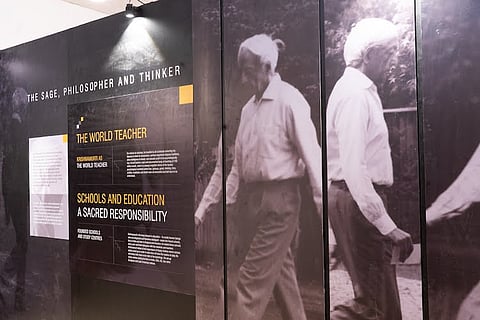

The Vasanta Vihar, ensconced in a quiet corner of Chennai, is a treasure that slowly reveals itself to the seeker. A white-walled bungalow with a bright cluster of bougainvillea perched atop the balcony, lies in the heart of Vasanta Vihar. The scene itself is similar to a flower pinned on someone’s pocket and this is where we will be taking our first as well as the last step.
J Krishnamurti, considered one of the greatest thinkers and philosophers of the century, made this profound statement - “First step is the last step” - during his dialogue with Pupul Jayakar, his biographer, in 1970. The meaning of it is that every first step that we’ve taken, we’ve also taken the last. Every first step has altered our perception entirely, thereby rendering every next step anew.
Born in the small town of Mandanpalle (then in Madras Presidency, now in Andhra Pradesh), Jiddu Krishnamurti went on to become a great spiritual teacher, spending most parts of his life travelling across the world and delivering speeches. The Krishnamurti Foundation established by Krishnamurti himself runs several educational institutes around the world.
“… That wherever we are, at whatever level of conditioning, of being, the perceiving of truth, of the fact, is at that moment, the last step,” is a part of J Krishnamurti’s quote on the topic.
For his 125th birth anniversary the Krishnamurti Foundation has come up with an immersive exhibit based on this very statement, featuring his life and teachings. The exhibit itself is divided into 4 parts: Voice, Study, Life and Teachings of which the first two are on the outside. Inside, a different world unfolds as we take the flight of stairs leading to Krishnamurti’s teachings. There’s Fear - a maze inside a dark cubicle from which you emerge, Religion - a walk leading towards the sacred, Violence - a tough descent towards nowhere, and more.
Bengaluru based designer and classical dancer Miti Desai who worked on the concept, design and direction in a very short span of 2 months shares that the subject has not been easy. Miti who had just finished working on 100 years of Kala Bhavana, the school inside Shantiniketan, when she began working on this exhibit asks, “How do you interpret that which is supportless through the support of form?”
Miti continues, “Krishanamrthi is taking you away from all forms of support and form with just the intellectual rigour. To interpret that has been the biggest challenge.”
“I took the lead from the “first step is the last step”. It is a very simple design from which a graphic structure emerges and builds on a non-linear format. The exhibition is viewed through different dimensions,” she explains. “Architecture has been consciously assimilated as an integral element of the design. Exhibition is viewed through different dimensions. For education its top down. Love, Death you look in a certain way. We’ve used rope, mirror, water… There’s massive space engagement. There’s dimensionality and materiality so that the core message of Krishnamurthi’s vision is released in an experiential exhibition,” she offers.
And true to her word, the exhibit gives you a very layered and immersive experience. Just before you set your eyes upon the white bungalow, a tall wild badam tree that stands poised in the middle of a circle-cut lawn draws you in. Here is the “voice”. The voice comes to you from different direction every time, carried to you by the gentle breeze or carried away from you by the wind.
We learn that it was here, under the wild badam, seated on a rock that lies just away from its shades, Krishnamurti gave his speeches to the public for close to 50 years. “It is one of my favourites in the exhibit. I wanted to recreate the banyan tree that is very integral to Krishnamurthi’s teachings. The suspension of the typography feels as if it has dissolved and is emerging back. The speaker is intentionally placed on top of the tree this gives the voice a feeling that it has dissolved and is emerging once again,” Miti adds.
She further tells us that it has been very interesting to observe how people have been interacting with this space. “They just sit, walk, lie down, some take notes…” she shares.
SP Kandaswamy, Secretary of the Krishnamurthi Foundation India (KFI) says, “Krishnamurti ji had a long term association with Vasanta Vihar and it was his thought that this place must remain a scared space made available for future generations. For his 125th birth anniversary, we have a series of programs planned and the exhibit is one of it. Through the end of this year all centres of KFI will have some program.”
While the exhibit closes in Chennai on February 8, it will travel next to Varanasi and open on the 17th of February where it will be showcased for 3 days. Later, it will be taken to Bengaluru. Miti who is working on all of it shares that most parts of it will be retained and the others alteres to suit the spaces. “All KFI campuses are identical and so the core idea is the same. But some elements maybe watered down due to constraints. In Varanasi, there’s a beautiful tree just by the Ganga and offers a great space to execute the “Voice”,” she shares.
The exhibit that has been in Chennai for a week will next travel to the Krishnamurthi Foundation centre in Varanasi and then to the centre in Bengaluru. The one in Chennai has been executed by Chennai based architecture firm Madras Terrace with lights by Krishna Kumar.